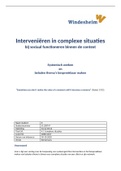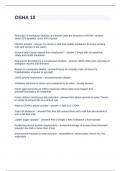Chemistry
Topic 2: Enthalpy, Entropy and Free Energy
Spontaneous Reactions
Some reactions occur spontaneously, for example magnesium and acid, whilst others need heat and
some reactions may never happen regardless of the heat applied. There are two reasons why
reactions might not happen:
1. Large activation energy
2. The reaction is not feasible (this does not just relate to the enthalpy of the reaction because
there are examples of endothermic reactions that are spontaneous)
There are two factors that decide if a reaction is feasible- Enthalpy and Entropy
Entropy, S, is sometimes described as a “measure of disorder” in a system. It is always a positive
value as all substances possess some degree of disorder because particles are always in constant
motion.
Entropy, S, is the quantitative measure of the degree of disorder in a system.
Entropy increases:
During changes of state that give more randomness
a) Solid – more ordered therefore lower value of entropy
b) Gas – less ordered therefore increased entropy
When a solid lattice dissolves
a) In solid – more ordered therefore lower value of entropy
b) When dissolved – less ordered therefore increased entropy
For a reaction in which there is a change in the number of gaseous molecules e.g. when a
gas is evolved. e.g MgCO3 (s) MgO(s) + CO2(g)
At 0K, perfect crystals have zero entropy
Calculating entropy changes, ΔS
Standard entropy change of reaction ΔSΘ is the entropy change that accompanies a reaction in the
molar quantities expressed in a chemical equation under standard conditions, all reactants and
products being in their standard states.
ΔSΘ = ΔSΘ (Products) - ΔSΘ (Reactants)
An increase in disorder of a system has a positive ΔSΘ
Calculate ΔSΘ for the reaction
N2(g) + 3H2(g) 2NH3(g)
N2(g) H2(g) NH3(g)
SΘ (JK-1mol-1) +192 +131 +193
Topic 2: Enthalpy, Entropy and Free Energy
Spontaneous Reactions
Some reactions occur spontaneously, for example magnesium and acid, whilst others need heat and
some reactions may never happen regardless of the heat applied. There are two reasons why
reactions might not happen:
1. Large activation energy
2. The reaction is not feasible (this does not just relate to the enthalpy of the reaction because
there are examples of endothermic reactions that are spontaneous)
There are two factors that decide if a reaction is feasible- Enthalpy and Entropy
Entropy, S, is sometimes described as a “measure of disorder” in a system. It is always a positive
value as all substances possess some degree of disorder because particles are always in constant
motion.
Entropy, S, is the quantitative measure of the degree of disorder in a system.
Entropy increases:
During changes of state that give more randomness
a) Solid – more ordered therefore lower value of entropy
b) Gas – less ordered therefore increased entropy
When a solid lattice dissolves
a) In solid – more ordered therefore lower value of entropy
b) When dissolved – less ordered therefore increased entropy
For a reaction in which there is a change in the number of gaseous molecules e.g. when a
gas is evolved. e.g MgCO3 (s) MgO(s) + CO2(g)
At 0K, perfect crystals have zero entropy
Calculating entropy changes, ΔS
Standard entropy change of reaction ΔSΘ is the entropy change that accompanies a reaction in the
molar quantities expressed in a chemical equation under standard conditions, all reactants and
products being in their standard states.
ΔSΘ = ΔSΘ (Products) - ΔSΘ (Reactants)
An increase in disorder of a system has a positive ΔSΘ
Calculate ΔSΘ for the reaction
N2(g) + 3H2(g) 2NH3(g)
N2(g) H2(g) NH3(g)
SΘ (JK-1mol-1) +192 +131 +193



